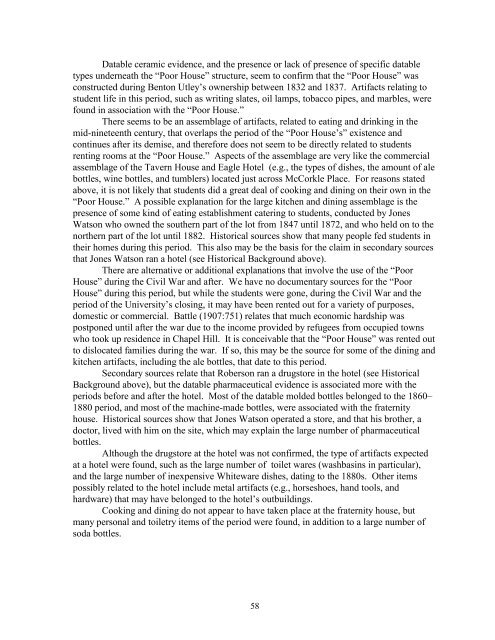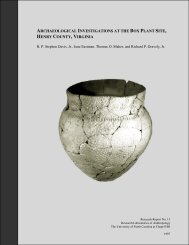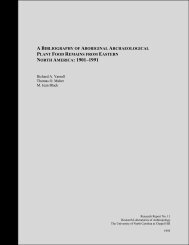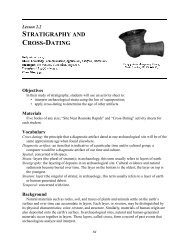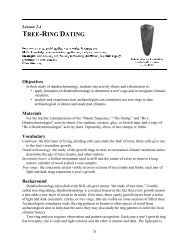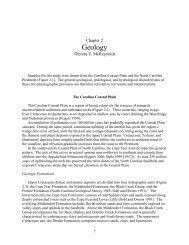Datable ceramic evidence, and the presence or lack <strong>of</strong> presence <strong>of</strong> specific databletypes underneath the “Poor House” structure, seem to confirm that the “Poor House” wasconstructed during Benton Utley’s ownership between 1832 and 1837. Artifacts relating tostudent life in this period, such as writing slates, oil lamps, tobacco pipes, and marbles, werefound in association with the “Poor House.”There seems to be an assemblage <strong>of</strong> artifacts, related to eating and drinking in themid-nineteenth century, that overlaps the period <strong>of</strong> the “Poor House’s” existence andcontinues after its demise, and therefore does not seem to be directly related to studentsrenting rooms at the “Poor House.” Aspects <strong>of</strong> the assemblage are very like the commercialassemblage <strong>of</strong> the Tavern House and Eagle Hotel (e.g., the types <strong>of</strong> dishes, the amount <strong>of</strong> alebottles, wine bottles, and tumblers) located just across McCorkle Place. For reasons statedabove, it is not likely that students did a great deal <strong>of</strong> cooking and dining on their own in the“Poor House.” A possible explanation for the large kitchen and dining assemblage is thepresence <strong>of</strong> some kind <strong>of</strong> eating establishment catering to students, conducted by JonesWatson who owned the southern part <strong>of</strong> the lot from 1847 until 1872, and who held on to thenorthern part <strong>of</strong> the lot until 1882. Historical sources show that many people fed students intheir homes during this period. This also may be the basis for the claim in secondary sourcesthat Jones Watson ran a hotel (see Historical Background above).There are alternative or additional explanations that involve the use <strong>of</strong> the “PoorHouse” during the Civil War and after. We have no documentary sources for the “PoorHouse” during this period, but while the students were gone, during the Civil War and theperiod <strong>of</strong> the University’s closing, it may have been rented out for a variety <strong>of</strong> purposes,domestic or commercial. Battle (1907:751) relates that much economic hardship waspostponed until after the war due to the income provided by refugees from occupied townswho took up residence in Chapel Hill. It is conceivable that the “Poor House” was rented outto dislocated families during the war. If so, this may be the source for some <strong>of</strong> the dining andkitchen artifacts, including the ale bottles, that date to this period.Secondary sources relate that Roberson ran a drugstore in the hotel (see HistoricalBackground above), but the datable pharmaceutical evidence is associated more with theperiods before and after the hotel. Most <strong>of</strong> the datable molded bottles belonged to the 1860–1880 period, and most <strong>of</strong> the machine-made bottles, were associated with the fraternityhouse. Historical sources show that Jones Watson operated a store, and that his brother, adoctor, lived with him on the site, which may explain the large number <strong>of</strong> pharmaceuticalbottles.Although the drugstore at the hotel was not confirmed, the type <strong>of</strong> artifacts expectedat a hotel were found, such as the large number <strong>of</strong> toilet wares (washbasins in particular),and the large number <strong>of</strong> inexpensive Whiteware dishes, dating to the 1880s. Other itemspossibly related to the hotel include metal artifacts (e.g., horseshoes, hand tools, andhardware) that may have belonged to the hotel’s outbuildings.Cooking and dining do not appear to have taken place at the fraternity house, butmany personal and toiletry items <strong>of</strong> the period were found, in addition to a large number <strong>of</strong>soda bottles.58
Chapter 6CONCLUSIONS AND RECOMMENDATIONSThe University <strong>of</strong> North Carolina at Chapel Hill is fortunate that many <strong>of</strong> its earliestbuildings are still standing, for they provide a unique character to the campus that evokesboth a sense <strong>of</strong> tradition and an appreciation <strong>of</strong> the University's formative years. However,the present campus bears only a superficial resemblance to the campus <strong>of</strong> the late eighteenth,nineteenth, and early twentieth centuries, and present-day Chapel Hill is even less a reflection<strong>of</strong> its former self. For much <strong>of</strong> its history, the University's student body was made up <strong>of</strong> onlya few hundred students, its faculty was very small, and its campus consisted <strong>of</strong> less than adozen permanent buildings at the south edge <strong>of</strong> Chapel Hill. Prior to the 1920s, when anambitious construction program under president Harry Chase's leadership began theUniversity's transformation into the modern institution that it is today, the campus's builtenvironment encompassed only the buildings that surround McCorkle Place and flankCameron Avenue. Significant portions <strong>of</strong> North Campus, such as Lot 11 where Battle-Vance-Pettigrew Buildings now stand, Lot 13 where Graham Memorial Building is located,and the area now occupied by Ackland Art Museum and Hanes Art Center (Lots 4 and 6),were still in private ownership at the turn <strong>of</strong> the century. Whereas today North Campus isflanked by a church, shops, and businesses along Franklin Street, before 1920 the north edge<strong>of</strong> campus consisted <strong>of</strong> two hotels, a church, stores, boarding houses, and private residences.Businesses in downtown Chapel Hill depended almost entirely on the University for theirexistence, and their economic prosperity was closely tied to the University’s well-being.The primary sources <strong>of</strong> information that now exist for understanding the character <strong>of</strong>the University and town in this bygone era are the diaries <strong>of</strong> students, faculty, and townfolk,histories written by persons such as Kemp P. Battle who lived during this period, the smallnumber <strong>of</strong> turn-<strong>of</strong>-the-century photographs which have survived, and archaeology. Of these,archaeology perhaps has the greatest potential for contributing to our increased understanding<strong>of</strong> the University's (and town's) past because this potential is largely untapped. Although theentire North Campus comprises a single, large archaeological site whose buried and <strong>of</strong>tenwell-preserved deposits document the University's history from its very beginning, only twosubstantial archaeological excavations—at the Graham Memorial and Pettigrew sites—havebeen undertaken on campus, and both <strong>of</strong> these took place within the last five years.However, these investigations have provided significant new information about town anduniversity life during the two previous centuries.Excavations at the Pettigrew site were conducted in order to identify and assess thesignificance <strong>of</strong> archaeological resources that might exist within the area <strong>of</strong> proposedconstruction for a new building to house the University <strong>of</strong> North Carolina’s Institute for theArts and Humanities. These excavations identified the architectural foundations for twobuildings—the “Poor House” and the Phi Delta Theta fraternity house—that stood during themid-nineteenth and early twentieth centuries, stratified soils about 1.5 ft thick that contain anabundance <strong>of</strong> artifacts associated with activities at the site from the late eighteenth centuryuntil the present, and a small number <strong>of</strong> prehistoric artifacts that date to the Archaic period (c.59
- Page 1 and 2:
ARCHAEOLOGICAL INVESTIGATIONS AT TH
- Page 3 and 4:
ABSTRACTArchaeological investigatio
- Page 5 and 6:
Moffitt, Brooks Rainey, Patricia Sa
- Page 7 and 8:
ChapterPage6. Conclusions and Recom
- Page 9 and 10:
TablePage16. Distribution of cerami
- Page 11 and 12:
FigurePage18. Excavating Sq. 140R95
- Page 13 and 14:
Chapter 1INTRODUCTIONThis report de
- Page 15 and 16:
Chapter 2HISTORICAL BACKGROUNDThe t
- Page 17 and 18:
Book 17:59-60). Gavin Hogg paid off
- Page 19 and 20: and the sale of the western half of
- Page 21 and 22: After the Civil War, the town fell
- Page 23 and 24: train young men and women to teach
- Page 25 and 26: the university was the Delta Kappa
- Page 27 and 28: ENDNOTES1 A typescript of this deed
- Page 29 and 30: Chapter 3FIELD METHODSFieldwork was
- Page 31 and 32: Chapter 4RESULTS OF ARCHAEOLOGICAL
- Page 33 and 34: foundations were 2 ft wide and the
- Page 35 and 36: Level 2aThis soil level occurred on
- Page 37 and 38: Feature 2Feature 2 was a linear dis
- Page 39 and 40: Feature 12Feature 12 was a small, s
- Page 41 and 42: ARCHITECTURAL GROUPA large number o
- Page 43 and 44: southern and northern parts of the
- Page 45 and 46: Kitchen GroupCeramics. As shown in
- Page 47 and 48: is probably no earlier than the sec
- Page 49: consumption of wine in ante-bellum
- Page 53 and 54: 50% of the assemblage). If, and whe
- Page 55 and 56: sat down. Diners then helped themse
- Page 57 and 58: ecords show his property increased
- Page 59 and 60: The ceramic marbles could easily be
- Page 61 and 62: southern to northern halves of the
- Page 63 and 64: anthropomorphic pipes (Sudbury 1979
- Page 65 and 66: TOILETRIES GROUPThe Toiletries grou
- Page 67 and 68: shampoo bottles, and a cosmetic jar
- Page 69: Items likely associated with the fr
- Page 73 and 74: REFERENCESAnonymousc.1797 Plan of t
- Page 75 and 76: Majewski, Teresita, and Michael J.
- Page 77 and 78: Wilson, Louis R.1957 The University
- Page 79 and 80: Table 1 continued.Activity Group Qu
- Page 81 and 82: Table 3 continued.Category 0-2 cm 2
- Page 83 and 84: Table 7. Distribution of kitchen ce
- Page 85 and 86: Table 10. Distribution of ceramic t
- Page 87 and 88: Table 13. Distribution of glass and
- Page 89 and 90: Table 17. Distribution of pharmaceu
- Page 91 and 92: PRESBYTERIANCHURCHHENDERSON STREETN
- Page 93 and 94: Figure 4. 1797 map of Chapel Hill a
- Page 95 and 96: Figure 6. 1857 Chapel Hill Business
- Page 97 and 98: Figure 8. View of Franklin Street l
- Page 99 and 100: Figure 10. Portion of a 1911 map co
- Page 101 and 102: Figure 12. Delta Kappa Epsilon hous
- Page 103 and 104: Figure 14. Kemp P. Battle with Phi
- Page 105 and 106: Figure 16. Portion of a 1932 map co
- Page 107 and 108: Figure 18. Excavating Sq. 140R95 pr
- Page 109 and 110: Figure 20. Removing topsoil from th
- Page 111 and 112: Figure 22. Exposing the south wall
- Page 113 and 114: Pettigrew Site(RLA-Or412)Architectu
- Page 115 and 116: Stone FoundationsStone FoundationsD
- Page 117 and 118: Figure 28. View of Structure 2 full
- Page 119 and 120: 160 150 140 130 120 110 100100 ft99
- Page 121 and 122:
Figure 32. Prehistoric lithic artif
- Page 123 and 124:
Figure 34. Miscellaneous ceramic an
- Page 125 and 126:
Figure 36. Glassware: oil lamp chim
- Page 127 and 128:
Figure 38. Stoneware: Virginia-made
- Page 129 and 130:
Figure 40. Refined, undecorated war
- Page 131 and 132:
Figure 42. Whiteware plate, 9.5”
- Page 133 and 134:
Figure 44. Transfer printed wares:
- Page 135 and 136:
Figure 46. Transfer printed wares:
- Page 137 and 138:
Figure 48. Toothbrushes and possibl
- Page 139 and 140:
Figure 50. Early to mid-nineteenth-
- Page 141 and 142:
Figure 52. Refined, undecorated whi
- Page 143 and 144:
Figure 54. Glass cosmetic and shamp
- Page 145 and 146:
Appendix 1. Chain of title for Lot
- Page 147 and 148:
30030024060300Lot 11George Johnston


